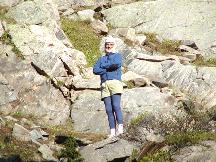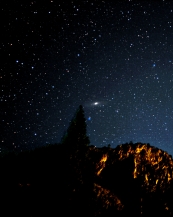Copyright © 2006,2009 images and text - Steven D. Carson. You may link to any photos here. Any other use requires consent from the copyright owner. Images are thumbnail links to a larger image (in firefox, Andromeda Rising has 3 increasingly larger images).
initial publication May 2009 (Steve sent this to me in Jun 2006, but I've been busy - Joe)
Table of Contents
 | Note |
|---|---|
| there is a companion article by Joe Trip Report: Mt. of the Holy Cross area, Colorado, USA. 8-15 Jun 2002 | |
It's been 4 years since Joe and I took the trip into the Holy Cross Wilderness, and I've been back soveral times. I usually go for peace, an occasional fish, and the outside chance of a spiritual moment. There was no spiritual moment on the trip with Joe, but it was quite entertaining, and I derive fresh amusement each time I read his Trip Report. He has a knack for story telling. I'm probably overdue in adding my perspective to the tale.
I've known Joe for about 30 years
during which time we've enjoyed intermittant correspondence. He usually emails me with changes of circumstances, and I email him when I need his help with a current project (e.g. electronics or astronomy).
I don't invite just any Joe to go backpacking with me, but I had been regaled with tales of his bushwalking experiences in the States as well as Down Under, including a January encampment on the rim overlooking Monument Valley (his subsequent adventure into parenthood proved that injury from that outing was overstated). I expected him to be sufficiently experienced that he posed little risk to either of us on this trip. Nevertheless, we went to a location I had visited before, and the schedule was appropriate for two 50-somethings with no better place to be.
As for the trip, Joe's narrative tells most of the story. A few details deserve comment. I will distance myself from his political and social commentary. There are some things about which we disagree, but I enjoy too few friends to lose any over philosophical differences.
Since Joe wrote his report for his old bushwalking buddies, and they subsequently picked it up as a high altitude experience, I must pass on a few personal thoughts. First, I'm still amazed that Joe made the trip in his volleys (for the uninitiated, volleys are nothing but light canvas sneakers - not even real tennis shoes). Trips in the Rockies frequently cross scree fields, downed timber, brush and thistles, and streams. It's almost always rocky. There is often mud (Joe missed out on rain). Any injury that keeps you from walking out can be life-threatening. I take care of my feet and ankles. Before orthotics reduced the need, I wore ankle braces. A twisted ankle with a heavy pack can be a broken ankle. I recommend substantial hiking boots (protect the arch and the ankle), double socks (blisters, bad), and check ahead of time to see how the boot sole behaves on wet rocks and logs (if it's too slippery, get a different boot). Joe also chose not to pack any long pants (other than his undies)
For some hikes that's OK. Many Colorado natives and visitors hike in shorts. Note the previous mention of brush, thistles, and downed timber, and don't say you didn't know. I wear long pants, long-sleeved shirts (sleeves role up), and a broad-brimmed hat. This helps with the brush, the sun, the mosquitos (they do in fact come out before dusk- 24/7), and the cool evenings.
As Joe reported, I used his sunscreen, late, on my hands and face. My face does not usually burn due to the hat, but this trip had considerably more reflected sunlight (more snow). I did have sunscreen with me, but it is also a serious insect repelant (why add two layers of grease when one will do?). It'seems that DEET dissolves everything, including GPS, compass, camera, etc., so it doesn't get used unless the mosquitos are relentless. It was nice that Joe offered. I may change my ways.
Unfortunately, Joe waited until the end of the trip to mention his allergy. Not only did I have antihistamines, I always have a reasonable first aid kit in my pack, and a smaller bandaids and disinfectant kit (with ammonia inhalants, in case my brother sees blood) in the fanny pack that is always with me (it also contains my small survival kit and poncho).
The usual recommendations for backwoods travel all apply. Tell somebody where, when, and how long. Stick to the plan. Don't hike alone. I make exception to this one on occasion. I can't always find company, and I'm going with or without. Besides, going alone seems to increase the chances for that spiritual moment. When I go alone, I go exactly where I've said I'm going; I don't go to the cathole without the fanny pack; and it's always an easy trip to a well known location. I have been on trips and seen no one for five days (yes, it is possible, though not likely on most occasions). Personal emergency rescue beacons are now available for $500 or so. Eventually, family will give me one, and I'll be required to take it. (Update- PLB for Christmas, 2009, and they are now less expensive.)
In fairness to him, Joe deserved to be tired when we reached camp 1. I have a slow and plodding approach to backpacking. I'm an out-of-shape academic. I live 800 ft above sea level. And, I carry too much stuff. I plan to only go 2-4 miles per day, depending on elevation gain and trail difficulty, with frequent rests, especially early in the trip. Several of my repeat trips have minimal elevation gain in the first several miles. Not so with this one, which starts on a steep grade and continues so for all but the last few hundred yards into camp 1 (and resumes thereafter). Joe had whipped himself into shape on his lunch-hour walks and was quite capable of hiking on ahead of me, which he did. I'm not sure whether it was to report the latest observation on the trail, or to check and see if I was still making progress, but he kept hiking back down the trail to socialize. By the time we reached camp, I had walked about 2 miles while Joe had walked 3 to 4, at twice my pace. This still amuses me to no end.
Joe got most of my point about tying the food up. Recommendations from the Forest Service and in camping how to publications are that food should be hung over a tree limb and suspended at least 10 ft above the ground. This is to keep bears (and others) out of the pantry. In all my years of hiking in the Colorado Rockies, I've never seen a bear. I've seen bear droppings on a couple of trips, and what looked to be dead logs torn apart by bears looking for insects, but I've never seen a bear (the pantry for a good picture might be a reasonable trade-- near the end of the trip; but a bear that learns to associated campers with food can be dangerous and soon dead). I've also never camped near a tree with a branch conveniently sticking out 10 ft above the ground. The spruce and fir in the places I camp typically have their longest branches near the ground (think traditional Christmas tree). It's much easier to run a rope between trees at 8-9 ft above the ground than to figure a way to hang the food over a limb way up there, with all the lower limbs being longer. I usually manage to get the bottom of the food bag between 6 and 7 feet off the ground. This has been sufficient to keep the squirrels, chipmunks, weasels, marmots, and fox (all of which I have seen) out of the food. It may be marginal for coyotes (heard but seldom seen), and probably won't stop a bear. This issue is more troublesome as one camps closer to tree line, where tall trees, if there are any, are scattered. There are sufficiently numerous people travelling the back country that the animals have learned that campers mean food. Some are careless; some feed the animals deliberately (highly discouraged). Don't leave food in your tent or your pack. Wash your dishes away from camp, as well as away from lakes and streams.
As for campfires, I have enjoyed many campfires on my trips, and fresh trout wrapped in foil and baked in the coals are unforgettable. Joe mentioned the forest fires during our trip. Open fires were prohibited due to the high fire danger across the region. Stoves are the only option during such prohibitions. I've used only my camp stove for the last many years for a number of reasons, including being too lazy (tired) to chop wood and not wanting to smell like smoke in my sleeping bag. We were camped in a wilderness area where one has the chance to experience solitude if so desired (there are parts of many wilderness areas where you might as well be be in a roadside campground sans cars and Winnebagos; I try to camp at other locations). Logs arranged into benches, trash left behind, and fire rings all intrude on the experience. Over the years, I have come to truly value the only footprints philosophy. The smell of a campfire travels in the mountains, and intrudes on the solitude of others who are sharing the experience - even as they are trying to forget that it is indeed a shared experience.
Drinking the fresh mountain water without pretreating is an experience I miss dearly. If I find a spring coming out of the ground, high up and well off the trail, I may still indulge, against all official advice. Otherwise, I filter the water used for drinking and cooking. (Pumps and filters break. I carry iodine tablets in the survival kit.) On the trail to one of my favorite sites (over the ridge from where Joe and I went), there is a wonderful fresh water spring called Toothache Spring (one of many, I'm sure) due to the cold water. In my youth, there was a cup hung on a peg by the spring. The cup has been gone for many years, and the spring is no longer labeled on backwoods maps. On my last trip, as I filtered water into my canteen, another hiker's dog ran through the spring (with the increase in people in the wilderness, there is a decrease in courtesy and consideration - and a need to filter even the purest water.....).
Crossing snow fields --- would you dive into unknown muddy water? As Joe pointed out, in spring and early summer the drifts are not firm, and frequently only bridges. Falling through is one danger, and that can be mitigated by hiking on only shallow drifts. The danger that is not mitigated is that something sharp, or a deep sink hole, could lie beneath even a shallow drift. We circumnavigated the drifts to the greatest possible extent, and were otherwise very careful. Consider the potential consequences of each decision.
Joe missed out by going to bed before dark. The stars are grand. This is a picture I took on a trip in 2005 -- Andromeda rising, during a full moon! (coincidentally at camp 1).
Take some long pants, a warm jacket, a pair of gloves, and enjoy the whole experience. Besides, the weather could turn nasty, and then you'll be glad you had them at lunch.


